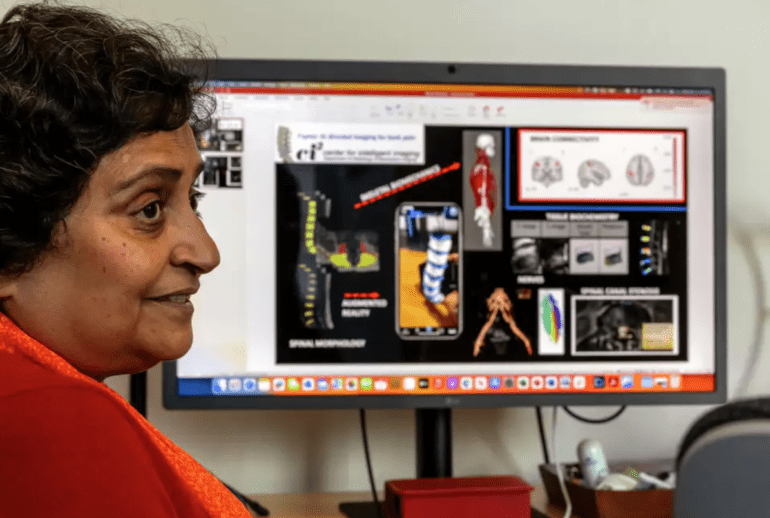TL;DR:
- UCSF researchers are leveraging AI to enhance medical imaging analysis, particularly in diagnosing lower back pain.
- AI can precisely grade afflictions like spinal disc degradation and spinal canal narrowing from MRI scans.
- Lower back pain is a leading global cause of disability, often difficult to diagnose accurately.
- The Back Pain Consortium (BACPAC), funded by NIH, supports AI-driven initiatives to combat opioid addiction.
- AI technology is already aiding UCSF doctors in imaging decision support.
- Startups like Prenuvo are exploring AI’s potential to expedite MRI scans.
- AI’s role is to support, not replace, human expertise in medical imaging.
- AI algorithms can optimize data processing, reducing patient scan time.
- AI has vast potential in broadening its impact on various medical conditions and insights from patient databases.
Main AI News:
Artificial intelligence (AI) is no longer confined to answering questions or generating captivating visuals from a few words. It has seamlessly integrated into the healthcare sector, particularly in the realm of medical imaging analysis. At the forefront of this medical revolution are researchers at the University of California, San Francisco (UCSF), who are harnessing AI’s immense potential to decipher complex medical scans, such as Magnetic Resonance Imaging (MRI), and unveil novel perspectives on disease detection and diagnosis.
UCSF’s Pioneering AI Applications
UCSF researchers have embarked on a groundbreaking journey to augment the capabilities of medical professionals by leveraging AI’s prowess. In collaboration with the Center for Intelligent Imaging within the Department of Radiology and Biomedical Imaging, AI has rapidly evolved to assist in reading and interpreting medical scans, offering a level of precision and insight previously unattainable.
Enhancing Diagnosis and Quantification
Dr. Sharmila Majumdar and her team at UCSF have directed AI toward the intricate challenge of diagnosing lower back pain, a prevalent and elusive medical condition. Lower back pain, affecting nearly a quarter of adults worldwide, has long posed diagnostic dilemmas. However, AI, after extensive training on numerous lower back MRI scans, now excels at precisely grading afflictions, such as spinal disc degradation or spinal canal narrowing.
The Global Burden of Lower Back Pain
The significance of this breakthrough cannot be overstated. Lower back pain is the leading cause of disability globally, as stated by the World Health Organization. Yet, for approximately 90% of sufferers, the source of pain remains elusive, leading to issues like opioid over-prescription and the associated risk of addiction. UCSF’s AI-driven approach aims to standardize interpretations, potentially revolutionizing the diagnosis of lower back pain.
The Back Pain Consortium (BACPAC)
Funded by the National Institutes of Health (NIH), the Back Pain Consortium (BACPAC) represents a collaborative effort involving 14 organizations, including universities and medical schools. This initiative aligns with federal endeavors to combat opioid addiction by advancing AI technologies. While the technology has not yet received FDA approval for clinical use, UCSF doctors already employ it as part of their imaging decision support.
A Glimpse into the Future
UCSF’s pioneering AI technology extends beyond lower back pain. Innovative applications include AI-assisted analysis of chest X-rays in select hospitals and clinics. Dr. Cynthia Chin, a radiologist at UCSF, envisions the potential for AI to define precise thresholds for conditions and associated pain, paving the way for more effective treatments.
AI: An Enabler, Not a Replacement
Despite the remarkable progress in AI-driven medical imaging, Dr. Majumdar emphasizes the importance of AI serving as a support tool for radiologists, rather than an automated replacement. The synergy between human expertise and AI algorithms can maximize diagnostic accuracy and treatment decisions.
AI’s Role in Data Enhancement
In addition to interpretation, AI algorithms can optimize data processing by ‘cleaning’ redundant data in MRI scans. This process reduces image noise, minimizing the time patients spend in scanners, a significant advancement in patient comfort and efficiency.
Beyond UCSF: Expanding AI Applications
UCSF is not alone in exploring the potential of AI in healthcare. Startups like Prenuvo are also delving into AI’s role in enhancing MRI scans. By resolving lower resolution images from shorter scans, AI has the potential to expedite imaging processes significantly.
A Promising Future
As AI continues to evolve, its applications in medical imaging expand. Dr. Majumdar envisions further funding to broaden AI’s impact on various ailments. With vast patient databases containing valuable reports, AI’s language-processing capabilities hold the promise of unearthing new insights into complex diseases.
Conclusion:
UCSF’s pioneering work in harnessing AI for medical imaging marks a significant step towards unraveling the mysteries within our interconnected bodies. AI’s role in the healthcare industry is undeniably transformative, promising a future where accurate diagnoses and treatments are within reach for a multitude of medical conditions.

